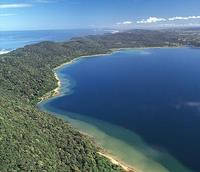 艾賽門加利索(iSimangaliso)溼地公園管理處與世界銀行簽署了一項900萬美金的捐款協議,用以展開名列於聯合國教科文組織世界遺產的保育活動,其中包括了非洲最大的河口,聖露西亞湖(Lake St Lucia)。艾賽門加利索在祖魯語是奇蹟的意思。
艾賽門加利索(iSimangaliso)溼地公園管理處與世界銀行簽署了一項900萬美金的捐款協議,用以展開名列於聯合國教科文組織世界遺產的保育活動,其中包括了非洲最大的河口,聖露西亞湖(Lake St Lucia)。艾賽門加利索在祖魯語是奇蹟的意思。
「該公園是一個重要的自然資產,在促進區域經濟發展中扮演著潛在的重要角色,」公園管理局執行長札留米斯(Andrew Zaloumis)在3月24日的簽署儀式中說道。
南非前總統曼德拉(Nelson Mandela)曾說:「艾賽門加利索是地球上唯一的地方,同時擁有世界最古老的陸地哺乳動物(犀牛)、最大的陸地哺乳動物(大象)、最古老的魚(腔棘魚)和最大的海洋哺乳動物(鯨魚),並且這些動物共享一個生態系統。
在艾賽門加利索濕地公園及周邊區域發展、執法與保育計畫的目標,是在刺激地方經濟發展的同時,透過重建生態的關鍵過程,來改善聖露西亞胡與烏姆弗洛齊河流域(Umfolozi River System)生態系統的功能。
「這項計畫的創新之處在於,它結合了保育目標與空間發展策略,來促進地方經濟發展。」計畫負責人,世界銀行非洲區經濟學家阿戈斯帝尼(Paola Agostini)說,「最根本的是,當地民眾必須獲得利益,使他們有保護環境的動力。」
札留米斯說:「我們未來5年的目標是,有意義的增加流入聖露西亞湖的淡水量,並將公園從一個落後的旅遊資產,改變成為一個在區域經濟成長中扮演重要角色的主要土地資產。」
由於它的自然風光與獨特的全球價值,艾賽門加利索溼地公園在1999年12月,成為南非第一個名列世界遺產(World Heritage Site)的地區。
該地區是史瓦濟蘭、通加以及祖魯人的家鄉,每個民族都有不同的文化、語言和習俗,包括700年的捕魚傳統。
艾賽門加利索溼地公園的前身是大聖露西亞溼地公園(Greater St. Lucia Wetland Park),區域範圍由聖露西亞角(Cape St. Lucia)向北延伸220公里到莫三比克,涵蓋14個不同的自然保護區。
公園面積廣達33萬2千公頃,其中包含非洲最大的河口系統,3個湖泊系統,8個相關聯的生態系統,大部分南非僅存的沼澤森林以及有2萬5千年歷史、世界最高的海岸沙丘。
公園內有黑犀牛、白犀牛、豹、大象、河馬、鱷魚、斑馬和羚羊,526種鳥類,植物種類超過3000種。 海豚、座頭鯨、海龜和大約250種魚類則棲息在沿岸水域。
祖魯野生動物電子論壇(Zululand Wildlife eForum )的康登(Tim Condon)呼籲當地社區「停止批准非法的開發活動」,並阻止人們闖入國家保護的沙丘森林區。
沙丘森林的非法土地開發糾紛發生在高斯灣(Kosi Bay)的邦加尼克(Bhanga Nek)保護區以及南方稍遠的西巴雅湖(Lake Sibaya)馬比比(Mabibi)保護區內。
公園的官員還宣布,將花費1億2千5百萬南非幣(約合台幣5億4千萬)投資旅遊產品與當地青年的教育課程。扎留米斯說:這個方案目前經援的80個本地企業將會逐漸擴大規模,而當地青年也將因此得到在將來成為公園管理者、執行長以及旅遊企業家的機會。
目前已經有8名學生獲得助學金補助,並且就讀於夸祖魯-納塔爾大學(KwaZulu-Natal University)和德班理工大學(Durban University of Technology)的旅遊、保育以及財務管理相關領域之中。
The iSimangaliso Wetland Park Authority and the World Bank Group have signed a US$9 million grant agreement to launch conservation activities in the UNESCO World Heritage site that contains Africa's largest estuary, Lake St Lucia. The name iSimangaliso means miracle and wonder in the Zulu language.
"The park is a major natural asset that has the potential to play an important role in fostering economic growth in the region," said Andrew Zaloumis, CEO of the iSimangaliso Wetland Park Authority at the signing ceremony March 24.
Former South African President Nelson Mandela has said, "iSimangaliso must be the only place on the globe where the oldest land mammal [the rhinoceros] and the world's biggest terrestrial mammal [the elephant] share an ecosystem with the world's oldest fish [the coelacanth] and the world's biggest marine mammal [the whale]."
The goal of the development, empowerment and conservation project in the Isimangaliso Wetland Park and surrounding regional area is to improve ecosystem functioning of the Lake St. Lucia and Umfolozi River System through restoration of key ecological processes while stimulating local economic development.
"The project is innovative because it combines conservation objectives with spatial development approaches for fostering local economic development," said project leader Paola Agostini, World Bank economist in the Africa region. "It is essential that the benefits must reach local people so that their energies can be mobilized for environmental protection."
Zaloumis said, "Our goal in the next five years is to meaningfully increase the flow of fresh water into Lake St. Lucia and move the park from being an underdeveloped tourism asset to a major territorial asset that will play an important role in the region's economic growth initiative."
The iSimangaliso Wetland Park was listed as South Africa's first World Heritage Site in December 1999 in recognition of its natural beauty and unique global values.
The area is home to the Swazi, Thonga and Zulu people, each expressing a distinct culture, language and customs, including 700 year old fishing traditions.
The iSimangaliso Wetland Park, formerly called the Greater St. Lucia Wetland Park, stretches 220 kilometers (136 miles) from Cape St. Lucia north to Mozambique and encompasses 14 distinct nature reserves.
The 332,000 hectare (1,281 square mile) park contains Africa's largest estuary system, three major lake systems, eight interlinking ecosystems, most of South Africa's remaining swamp forests, and 25,000 year-old coastal dunes that are among the highest in the world.
The park is inhabited by black and white rhinos, leopards, elephants, hippos and crocodiles, zebras and antelopes, 526 bird species and more than 3,000 plant types. Dolphins, humpback whales, sea turtles and some 250 fish species inhabit the coastal waters.
Condon called upon the local communities to "stop the approval of illegal development activities" and to keep people from trespassing into the state protected dune forest areas.
The illegal development dispute sites in the dune forest are within the designated protected area at both Bhanga Nek on Kosi Bay and farther south at Mabibi on Lake Sibaya.
Park officials also announced the investment of R125 million into its tourism product and an education program for local youths. Zaloumis said the program, which now supports 80 local entrepreneurs will be broadened and local young people will be empowered to become the park managers, CEOs and tourism entrepreneurs of tomorrow.
Bursaries have been approved for eight students now registered with KwaZulu-Natal University and Durban University of Technology in fields related to tourism, conservation, development and financial management.





